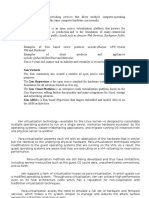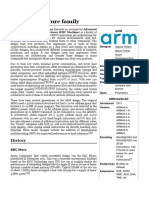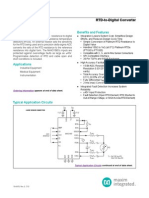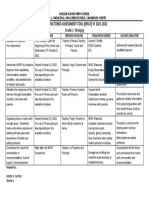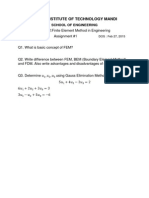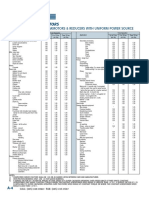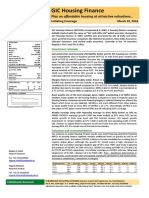SCALE 13x
Contemporary
Device Tree
Matt Porter
Konsulko
mporter@konsulko.com
�Overview
History of Device Tree (DT)
Linux kernel use of DT
Device Tree Basics
Device Tree Examples
Modifying Device Trees
Dynamic Device Tree Overlays
�History of Device Tree (DT)
Sun Microsystems - Open Boot / Open
Firmware (1988)
Used in SPARC systems
Uses DT to describe hardware
IEEE-1275 formalized specification (1994)
Documents DT
Apple adopts Open Firmware on Power Mac
7200 (1995) using DT
Common Hardware Reference Platform
(CHRP) specifies DT (1995)
ePAPR specifies DT (2008)
�DT in the Linux kernel
SPARC
All systems pass DT so its supported for a long time
in the kernel
PowerPC
PowerMacs also drove support of DT in the kernel
Major reorg in 2005 merging 32-bit/64-bit required all
platforms to use DT
x86
Yes, really. CE4100 Falconfalls uses DT
�DT in the Linux kernel
ARM
Linus ultimatum to ARM community (2011)
http://lists.infradead.org/pipermail/linux-armkernel/2011-April/048543.html
All new platforms must use DT to describe hardware
MIPS
Fall out from Linus ultimatum, Ralf Baechle begins
MIPS conversion to DT
http://www.linux-mips.org/archives/linuxmips/2011-06/msg00059.html
Microblaze
Using DT in 2008, driven by flexible FPGA I/O
�Defining Device Tree
ePAPR defines DT
https://www.power.org/documentation/epaprversion-1-1/
a concept called a device tree to describe
system hardware.
A device tree is a tree data structure with
nodes that decribe the physical devices in a
system.
[a] device tree describes device information
in the system that cannot be dynamically
detected by a client.
�Device Tree Basics
Nodes
Groupings of properties and child nodes
Properties
Key-Value Pairs
Text strings my string
Cells (32-bit) <0xdeadbeef 11 0xf00d>
Binary data [0x01 0x02 0x03 0x04]
mixed data, concatenate with a comma
my string, <0xdeadbeef>, [0x04], your string
Phandles
Reference to another node
�Device Tree Source Format
/ { Node name and unit address
String, list, and binary
property values
node1@0 {
a-string-property = "A string";
a-string-list-property = "first string", "second string";
a-byte-data-property = [0x01 0x23 0x34 0x56];
child-node1@0 {
first-child-property;
second-child-property = <1>; Phandle
third-child-property = <&node2>;
a-string-property = "Hello, world";
};
child-node2@1 {
};
Label
};
node2: node2@1 {
an-empty-property;
a-cell-property = <1 2 3 4>; /* each number (cell) is a uint32 */
child-node1 {
};
};
};
�Device Tree Node Example
Unit address is the memory mapped I/O address of this UART
uart0: serial@44e09000 {
An identifier for this hardware which allows the operating system to
match a compatible driver to the peripheral.
compatible = "ti,omap3-uart";
Vendor specific properties are prefixed with a vendor ID
ti,hwmods = "uart1";
Input clock frequency for this UART
clock-frequency = <48000000>;
Base address of length of the memory mapped I/O
reg = <0x44e09000 0x2000>;
Interrupt number
interrupts = <72>;
Device is not enabled
status = "disabled";
DMA engine properties, phandle to DMA deivice node and channels used
dmas = <&edma 26>, <&edma 27>;
dma-names = "tx", "rx";
};
arch/arm/boot/dts/am33xx.dtsi
�Device Tree Driver Example
Compatible strings this driver matches
#if defined(CONFIG_OF)
static const struct of_device_id omap_serial_of_match[] = {
{ .compatible = "ti,omap2-uart" },
{ .compatible = "ti,omap3-uart" },
{ .compatible = "ti,omap4-uart" },
{},
};
MODULE_DEVICE_TABLE(of, omap_serial_of_match);
Probe will be run when a matching
#endif
compatible string is found
static struct platform_driver serial_omap_driver = {
.probe
= serial_omap_probe,
.remove
= serial_omap_remove,
.driver
= {
.name
= DRIVER_NAME,
.pm
= &serial_omap_dev_pm_ops,
.of_match_table = of_match_ptr(omap_serial_of_match),
},
};
drivers/tty/serial/omap-serial.c
�Device Tree Platform Example
&am33xx_pinmux {
...
Child node contains platform specific pin mux settings for UART0
uart0_pins: pinmux_uart0_pins {
pinctrl-single,pins = <
0x170 (PIN_INPUT_PULLUP | MUX_MODE0)
0x174 (PIN_OUTPUT_PULLDOWN | MUX_MODE0)
>;
};
};
...
Pinctrl properties contain pin mux settings that are
&uart0 { referenced here via phandle
pinctrl-names = "default";
pinctrl-0 = <&uart0_pins>;
Marking this device enabled instantiates the device in the kernel
status = "okay";
};
arch/arm/boot/dts/am335x-bone-common.dtsi
�Device Tree Bindings
ePAPR defines as
...requirements, known as bindings, for how
specific types and classes of devices are
represented in the device tree.
Maintained in Linux kernel
Documentation/device-tree/bindings/*
Follow standards and conventions established in
IEEE1275 and ePAPR
Each type and class of device has a DT
binding describing all of the valid properties
and their behavior
�Device Tree Binding Example
OMAP UART controller
Required properties:
- compatible : should
- compatible : should
- compatible : should
- ti,hwmods : Must be
be "ti,omap2-uart"
be "ti,omap3-uart"
be "ti,omap4-uart"
"uart<n>", n being
for
for
for
the
OMAP2 controllers
OMAP3 controllers
OMAP4 controllers
instance number (1-based)
Optional properties:
- clock-frequency : frequency of the clock input to the UART
Whoa, wait, this is a terrible example. This
binding doesnt show the reg, interrupt, or
dmas properties that are clearly used in the
working dtsi source files UART node.
Documentation/devicetree/bindings/serial/omap_serial.txt
�FIXED Device Tree Binding Example
OMAP UART controller
Required properties:
- compatible : should be "ti,omap2-uart" for OMAP2 controllers
- compatible : should be "ti,omap3-uart" for OMAP3 controllers
- compatible : should be "ti,omap4-uart" for OMAP4 controllers
- reg : address and length of the register space
- interrupts: Should contain the uart interrupt number
- ti,hwmods : Must be "uart<n>", n being the instance number (1-based)
Optional properties:
- clock-frequency : frequency of the clock input to the UART
- dmas: DMA specifier, consisting of a phandle to the DMA controller
node and a DMA channel number.
- dma-names: rx for RX channel, tx for TX channel.
Example:
uart0: serial@44e09000 {
compatible = "ti,omap3-uart";
ti,hwmods = "uart1";
};
�Managing Device Tree Source (DTS)
DTS files found in arch/foo/boot/dts/ on
ARM, MIPS, PowerPC, and MicroBlaze
A DTS file is compiled into a Device Tree
Blob (DTB)
The resulting DTB is passed to the kernel at boot
All devices are created using the contents of the
DTB.
DTS files may include other files
�BeagleBone White/Black DTS/DTSI
am335x-bone-black.dts
am335x-bone.dts
am335x-bone-common.dtsi
am33xx.dtsi
am335x-evm.dts
�Compiling DTBs
The Device Tree Compiler (dtc) is used to
compile DTS -> DTB
Found in scripts/dtc
Invoking dtc from the kernel tree
make dtbs
will generate DTBs for each DTS in
arch/foo/boot/dts/*
Runs C preprocessor on source files
Invoking dtc directly
dtc -I dts -O dtb -o myboard.dtb myboard.dts
�Adding an I2C device to a board
&am335x_pinmux {
...
Add this i2c1 pins node which defines pinmux settings for BeagleBlack P918 and P9-17 to be muxed as I2C1_SDA and I2C1_SCL, respectively. The
property values are gathered from a combination of the board manual, SoC
datasheet, and the pinctrl single binding.
i2c1_pins: pinmux_i2c1_pins {
pinctrl-single,pins = <
0x158 (PIN_INPUT_PULLUP | MUX_MODE2)
0x15c (PIN_INPUT_PULLUP | MUX_MODE2)
>;
};
...
};
The i2c1 device node included from the am33xx.dtsi is overlayed with board
specific properties. The pinctrl properties reference the above pinmux
configuration for the I2C pins and the clock frequency is set according to the
device capabilities on the I2C bus. Finally, the i2c controller is enabled. Note
that the i2c1 device node defaults to disabled in am33xx.dtsi.
&i2c1 {
pinctrl-names = "default";
pinctrl-0 = <&i2c1_pins>;
clock-frequency = <400000>;
status = "okay";
The at24@50 child node instantiates a 24c256 I2C serial eeprom on the
parent I2C bus at address 0x50.
at24@50 {
compatible = "at,24c256";
pagesize = <64>;
reg = <0x50>;
};
};
Modifying arch/arm/boot/dts/am335x-boneblack.dts
�Dynamic Device Trees
Power architecture has had
CONFIG_OF_DYNAMIC
Destructive changes to the live device tree
Capebus introduced in 2012, a kernel
framework to dynamically modify the DT
based on pluggable hardware
Driven by Beaglebones standardized expansion
capes (Capebus shipped in the Beaglebone 3.8
kernel) .
Capebus discussions made way upstream
for the staged introduction of dynamic DT
overlays.
�Dynamic DT Overlays
Part of the kernel since 3.19
Introduces the concept of a DT fragment
A DT fragment is a DTB which contains symbols that
can only be resolved at runtime against the live tree.
Allows a user to insert a DT fragment into
the live tree at runtime and activate it
The inserted fragment becomes part of the tree in
the same manner as if it were compiled into the DTB
and passed at boot time.
A configfs interface is used to specify DT
fragments to be applied to the live tree
�DT Fragment Format
Use overlay enabled dtc from https://github.com/pantoniou/dtc
Borrowing Pantelis Antonious example:
/* qux.dts */
/dts-v1/;
Notifies dtc that this is a DT fragment.
/plugin/;
/ {
The dtc compiler will assign a phandle value of 0x00000001 to the baz node.
BAZ: baz { };
The dtc compiler will resolve &BAZ accordingly for a value of <0x00000001>.
qux = <&BAZ>;
The dtc compiler will mark property quux as requiring a fixup at runtime to resolve
&FOO.
quux = <&FOO>;
};
�DT Fragment Format Analysis
Compile it
$ dtc -O dtb -o qux.dtbo -b 0 -@ qux.dts
Dump it
$ fdtdump qux.dtbo
/ {
qux = <0x00000001>;
quux = <0xdeadbeef>;
baz {
linux,phandle = <0x00000001>;
phandle = <0x00000001>;
};
__symbols__ { BAZ = "/baz"; };
__fixups__ { FOO = "/:quux:0"; };
__local_fixups__ { qux = <0>; };
};
�Add I2C device: DT Overlay Version
/dts-v1/;
/plugin/;
/ {
fragment@0 {
target = <&am3353x_pinmux>;
__overlay__ {
i2c1_pins: pinmux_i2c1_pins {
pinctrl-single,pins = <
0x158 0x72
0x15c 0x72
>;
};
};
};
fragment@1 {
target = <&i2c1>;
__overlay__ {
pinctrl-names = "default";
pinctrl-0 = <&i2c1_pins>;
clock-frequency = <400000>;
status = "okay";
at24@50 {
compatible = "at,24c256";
pagesize = <64>;
reg = <0x50>;
};
};
};
};
at24-i2c1.dts
�Add I2C device: Build and Load
Overlay
$ dtc -O dtb -o at24-i2c1.dtbo -b 0 -@ at24-i2c1.dts
$ mkdir /config/device-tree/overlays/a24-i2c1
Loads and activates the DT fragment, enabling
the I2C1 controller and instantiating the 24C256
I2C EEPROM
$ cp at24-i2c1.dtbo /config/device-tree/overlays/at24-i2c1/dtbo
Deactivates and removes the DT fragment,
disabling the I2C1 controller and the 24C256 I2C
EEPROM
$ rmdir /config/device-tree/overlays/at24-i2c1
�Q&A
References
The Kernel Source
https://www.power.org/documentation/epaprversion-1-1/
http://devicetree.org
http://events.linuxfoundation.
org/sites/events/files/slides/petazzonidevice-tree-dummies.pdf
http://events.linuxfoundation.
org/sites/events/files/slides/dynamic-dtelce14.pdf

























